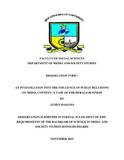Please use this identifier to cite or link to this item:
https://cris.library.msu.ac.zw//handle/11408/3495Full metadata record
| DC Field | Value | Language |
|---|---|---|
| dc.contributor.author | Makoma, James | - |
| dc.date.accessioned | 2019-03-28T12:59:05Z | - |
| dc.date.available | 2019-03-28T12:59:05Z | - |
| dc.date.issued | 2015 | - |
| dc.identifier.uri | http://hdl.handle.net/11408/3495 | - |
| dc.description.abstract | The study sought to investigate why public relations copy has been freely finding its way into media content with the end result being the fourth estate, journalism, losing its watchdog role to has now come to be known as the ‘fifth estate’, which happens to be public relations departments of various organisations. The researcher subjected to empirical study the phenomenon that led to media under study, The Herald Business to be a channel through which public relations copy reappeared as news, sometimes wholesomely and in other cases with minor alterations. In other cases public relations copy was found to have been disguised as donations and corporate functions such as breakfast meetings among other corporate events. The researcher sought to understand why there was that shift, by mass media practitioners, from relying on traditional sources of news such as the law courts and parliament and even the stock exchange activities to relying more on public relations practitioners and the material that they churned out. The researcher examined why despite all the gatekeeping mechanisms found at The Herald in general and The Herald Business in particular, public relations copy freely found its way into the newspaper. The researcher also sought to understand if there were other factors that might have led public relations copy to find its way into The Herald Business outside of the known lack of adequate resources and time constrains. The researcher found the existence of “safety first” journalism which happens to be an interplay between active public departments and fear. The research predominantly used the qualitative research approach although the quantitative paradigm was made use of to analyse statistical data. | en_US |
| dc.language.iso | en | en_US |
| dc.publisher | Midlands State University | en_US |
| dc.subject | Public relations | en_US |
| dc.subject | Media | en_US |
| dc.subject | Journalism | en_US |
| dc.title | An investigation into the influence of public relations on media content: a case of the Herald business | en_US |
| item.fulltext | With Fulltext | - |
| item.languageiso639-1 | en | - |
| item.grantfulltext | open | - |
| Appears in Collections: | Bsc Media And Society Studies Honours Degree | |
Files in This Item:
| File | Description | Size | Format | |
|---|---|---|---|---|
| James Makoma FINAL.pdf | Full Text | 1.12 MB | Adobe PDF |  View/Open |
Page view(s)
208
checked on Dec 19, 2025
Download(s)
80
checked on Dec 19, 2025
Google ScholarTM
Check
Items in MSUIR are protected by copyright, with all rights reserved, unless otherwise indicated.



